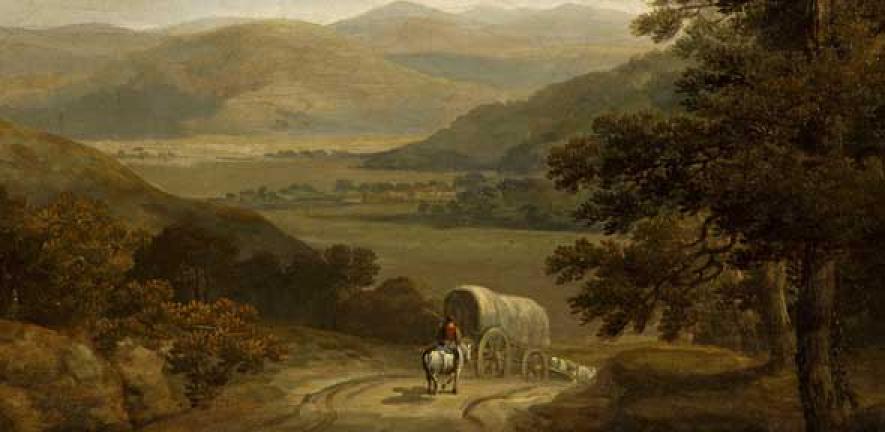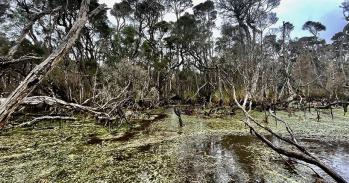
In a talk on Monday (20 May 2013) Dr Simon Nightingale will explore how painterly interpretations of the countryside were embedded into the literature of agricultural improvement in a way that might surprise modern readers.
In a talk on Monday (20 May 2013) Dr Simon Nightingale will explore how painterly interpretations of the countryside were embedded into the literature of agricultural improvement in a way that might surprise modern readers.
Dismissed as outdated flights of fancy, an important aspect of Young's writing has been lost to modern audiences.
Dr Simon Nightingale
The second half of the18th century witnessed a revolution in agriculture driven by individuals who saw in the emerging scientific methods of producing food the means of securing wealth for themselves and prosperity for the nation. The contemporary sources that tell the story of these improvements in farming provide a window on how people saw the land in its role as a provider, and how they worked with the resources that nature offered on a practical level, putting into motion the practices developed through careful experimentation.
A close reading of these publications and archival materials reveals a complex discourse which drew on artistic and literary traditions as well as the developing field of agricultural improvements. This overlap in the perceptions of land and landscape, how painterly interpretations of the countryside were embedded into at least some of the literature of agricultural improvement, represents one of the strands of my current research as a visiting scholar in the Department of History and Philosophy of Science (HPS).
On Monday, 20 May I will be talking about, ‘Seeing with words: tours, surveys and agricultural improvement in Britain, c 1770–c 1820’, in a presentation that will discuss how one man in particular – Arthur Young - embodied this blurring of boundaries. In an informal presentation intended to outline my preliminary thoughts on the topic, I will encourage my audience to drop the divides between disciplines and explore, through Young and his writing, the creative links which have come to inform our own way of seeing landscape.
The principal motor of agricultural improvement was the enclosure of common and waste lands, which abolished traditional common rights and transferred the land to private ownership. Although enclosure of common and waste lands had started much earlier, the second half of the 18th century saw a much more concentrated effort in that direction. In particular, parliamentary acts were increasingly used to facilitate quicker and more extensive enclosure. By the end of George III’s reign some six million acres had been transferred from waste or common land to privately owned enclosures.
The energetic traveller and commentator Arthur Young (1741-1820) is remembered as a promoter of enclosure and experimental agriculture as the means of improved farming. He was a prolific writer and tireless promoter of agricultural improvement, editor of the Annals of Agriculture between 1784 and 1809, secretary to the Board of Agriculture from its foundation in 1793 to his death, and centre of an international corresponding network that included Sir Joseph Banks, George Washington, the radical chemist Joseph Priestley, the Irish chemist and mineralogist Richard Kirwan, and a number of improving aristocrats in France, Poland and Russia. These letters reveal that agricultural advances were at the top of the agenda in circles that went far beyond that of farmers and landowners.
An easily accessible compilation of Young’s prodigious output is GE Mingay’s Arthur Young and His Times (1975). But even a most thorough perusal of that book, with its selection of farm accounts and experimental observations collated by Young, the economic aspects of farming and the political and social importance of agriculture, does not prepare the reader for the sort of dizzily romantic writing of which Young is capable.
Below is an extract from Six Months Tour Through the North of England in which Young, the man who elsewhere extolls the use of root vegetables and deep ploughing to enhance productivity, takes the reader deep into the intoxicating landscape of an English paradise.
We had not travelled many miles over the moors, before a most enchanting landscape, as if dropt from heaven in the midst of this wild desart, at once blessed our eyes. In ascending a very steep rocky hill, we were obliged to alight and lead our horses; nor was it without some difficulty that we broke through a shrubby steep of thorns, briars, and other underwood; but when it was effected we found ourselves at the brink of a precipice with a sudden and unexpected view before our eyes of a scene more enticingly pleasing than fancy can paint. Would to heaven I could unite in one sketch the cheerfulness of Zuccarelli with the gloomy terrors of Pousin, the glowing brilliancy of Claud, with the romantic wildness of Salvator Rosa. Even with such powers it would be difficult to sketch the view which at once broke upon our ravished eyes.
Incircled by a round of black mountains, we beheld a valley which from its peculiar beauty, one would have taken for the favourite spot of nature, a sample of terrestrial paradise. Half way up the hills in front many rugged and bold projecting rocks discovered their bare points among thick woods which hung almost perpendicular over a deep precipice. In the dark bosom of these rocky shades a cascade glittering in the sun, pours as is from a hollow of the rock, and at its foot forms an irregular bason prettily tufted with wood, from whence it flows in a calm tranquil stream around this small, but beautiful vale, losing itself among rocks in a most romantic manner. Within the banks of this elysian stream, the ground is most sweetly varied in waving slopes and dales, forming five or six grass inclosures of a verdure beautiful as painting can express. Several spreading tress scattered about the edges of these gentle hills have a most charming effect in letting the green slopes illumined by the sun, be seen through their branches; one might almost call it, the clear obscure of nature.
It’s certainly a far cry from Country Life or Farmers Weekly. In reading these words today, part of our surprise that a man devoted to the improvement of agriculture should write such heady prose arises from received notions of the incompatibility of a more utilitarian view of the land and one centred on its aesthetic qualities. Our distinction between nature and culture compartmentalises art from science, fact from feeling. So historians who deal with Young have tended to concentrate on his economics rather than his aesthetics, on his taste for experiment rather than his experiments with taste. Dismissed as outdated flights of fancy, an important aspect of Young's writing has been lost to modern audiences.
To understand Young’s (to us) overblown allusions to the charm and drama of the landscape it is necessary to bring to mind the cult of the picturesque – a gentler precursor to the romanticism of the later 18th and early 19th centuries and a notion rooted in a sensibility to aesthetic values. In a like manner, much of the scholarship on the picturesque and the place of landscape within it assumes a fundamental antagonism between the dictates of aesthetic sensibility and those of hard nosed utility, a dichotomy that we have come to know as the ‘two cultures’ – the humanities and the sciences. I argue that the distinction we assume between what is practical and what is aesthetically pleasing is not so clear cut.
It is significant that Young’s most popular published works – accounts of extensive tours undertaken in England, Wales, Ireland, France, Italy and Spain in the 1770s and 1780s – are as full of the picturesque as they are of the utilitarian. In his Annals of Agriculture, too, where one might have expected a more focused attention on the practical and useful, Young continued to offer his own general views of various farming regions that included attention to the aesthetics of landscape. In the same forum, Young also published a series of letters by Thomas Ruggles on ‘Picturesque farming’ in which the useful improvement of farming was pursued alongside its aesthetic melioration, which meant applying the principles of scenic beauty so a to render a view of the farm picturesque through the use of trees, hedges and other such features.
Moreover, while Young certainly resisted the more dogmatic attempts to see landscape only according to the rules of painting, there are clear and important parallels between the way Young structured his writing about the aesthetic qualities of landscape and the way in which landscape painters depicted their scenes visually. It is as if Young was painting with words. In this way, Young takes on the formal rules of William Gilpin, a major theorist of the picturesque aesthetic, but resists his rejection, itself never complete, of the “plough and the spade”.
My research involves parallel studies of literature and history of art with particular attention to ways in which they related epistemologically, socially and discursively. Hilly Landscape, the painting by Charles Towne reproduced here by kind permission of the Fitzwilliam Museum, follows the basic pattern employed by the classical landscape artist, Claude Lorrain. Firstly, the whole view is taken from a high vantage point which allows a distant horizon to be seen even though middle ground between the viewpoint and that horizon can rise up. This prospect gives the whole space a more enclosed frame, albeit leaving the suggestion that there is something beyond which the eye cannot see.
Towne thus achieves the impression of incredible depth and distance associated with Claude. As Richard Wilson (1714-1782), the Welsh landscape painter known as ‘the English Claude’, noted ‘you may walk in Claude’s pictures’. In Towne’s painting this is given added emphasis by the wagon and horse descending into the valley below; our eyes move with the travellers in the painting.
While differing in detail, the passage from Young’s Six Months Tour reproduced above certainly shares a lot of the features found in Hilly Landscape. Whatever we make of the way in which Young situated taste and utility, the two were closely connected. They can, in some respects, be seen as expressions of a single way of seeing that, while different in some respects, shared so many features as to allow slippage from the one to the other.
This could, of course, be something peculiar to Young. William Marshall (1745-1818), a rival of Arthur Young who was equally committed to agricultural improvement, dismissed Young’s ramblings as a confused and confusing hotchpotch of ‘paintings, pigs, and picturesque views’. But whereas Young travelled rapidly through the country to build up his picture of agriculture, Marshall advocated his own method of residing in the region under survey for lengthy periods of time. In other words, his way of seeing was more introverted and perhaps excluded those prospect views that Young shared with some landscape painters.
The same prospect view, moreover, is embedded in Young’s method of noting the agricultural practices of the regions he visited. When he himself farmed, he developed a system of conducting and recording experiments which moved from the practical business of husbandry to the economic costs and benefits that variations of these practices entailed. This approach was applied in his Tours and became also the model for the later Board of Agriculture’s County Surveys. While I don’t want to push this notion too far, it seems that oscillation between the physical and economic aspects of farming has its correspondence in the alternation between light and dark which allows a view of scenic beauty to become visible. In Young’s case, though, what becomes visible is the view of the farm not as a household, as had been very much the case earlier in the 18th century, but as an integrated unit of production. Where the landscape painter brought beauty into view, Young brought utility into view.
This combination of painterly and scientific ways of seeing, I suggest, offered what is possibly one of the first views of the capitalist economy. Whereas economic tracts from the 17th century to the first decade of the 19th offer ‘snapshot’ accounts of various economic subjects from balance of payments and trade to land and rent, money, population and taxation, there is no clear idea that something as unified as ‘an economy’ was perceived to exist. The compositional elements were there, but there was no picture. They lacked the sort of perspectives that made landscape art possible. With Young, who very clearly had a sophisticated sense of the aesthetic and a commitment to what he saw as economically and socially useful improvements, this changes.
Just why Young wrote like he did is, of course, explainable on various fronts. Not least is Young’s personal combination of aesthetics and practical improvement. But Young was by no means alone in this. Several writers of the Board of Agriculture’s County Reports, for example, also moved quite easily from aesthetic to practical concerns. Even William Marshall published works on gardening and the aesthetic improvement of estates. Moreover, the genre of the Tour was itself becoming more popular. Tourists to the Lake District, North Wales and the Scottish Highlands became increasingly common, and so too did travel guides. A sign, perhaps, of the structural changes occurring in both the economy and society, touring and travel literature, of which Young was a pioneer, gave wider currency to the ways of seeing that Young deployed; one of the most popular travel guides on the period, Thomas West’s Guide to the Lake District, even quoted Young at length. More tellingly, though, Young’s mixing of taste with utility would have rendered him a more reliable observer, a more trustworthy authority.
Displaying all the sensibilities of taste that marked a cultured gentleman of the period would give credibility and trustworthiness to what were, as far as his agricultural observations went, radical and often destabilising opinions. In nearly every account of the aesthetic qualities of natural landscapes that Young offered, for example, enclosed lands are present. That such a renowned theorist of aesthetics as Edmund Burke could write to Young asking for practical advice on farming is suggestive in this respect. By combining a radical agenda for improvement with a sense of aesthetic taste, Young secured a more receptive audience ready to see on the farm what they saw in the landscape.
Simon Nightingale will be talking about ‘Seeing with words: tours, surveys and agricultural improvement in Britain, c.1770–c.1820’ on Monday, 20 May, 1pm, at the Department of History and Philosophy of Science, Free School Lane, Cambridge. All welcome.
For more information on this story contact Alex Buxton, University of Cambridge Communications Office, amb206@admin.cam.ac.uk 01223 761673
This work is licensed under a Creative Commons Licence. If you use this content on your site please link back to this page.





